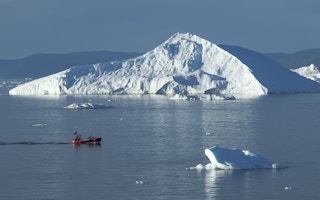Some of the world’s coldest places, on land and sea, may be plunged into an unstoppable transition to a climate system most scientists believe has not existed for 35-50 million years.
The almost immediate consequences would include the loss of reliable water resources for millions of people, and the start of a process leading to ultimate sea level rise of 4-10 metres or more.
The warning comes in a report by the International Cryosphere Climate Initiative (ICCI), a group of scientists, diplomats and others who say climate change “is happening in the cryosphere faster and more dramatically than anywhere else on earth”.
The report says that unless the negotiators at the COP21 climate change summit in Paris show far more ambition than they have so far, the verdict on this conference will be “too little, too late”.
Cryosphere dynamics
Pam Pearson, ICCI’s founder and director, introduced the report on the risks of irreversible climate change in the cryosphere − the scientific name for the parts of the world that are covered in ice and snow for part or all of the year – by saying: “We are worried by the disconnect between cryosphere dynamics and the policy response.”
The report warns of “the very great risks posed by the irreversible cryosphere thresholds”, and says that currentIntended Nationally Determined Contributions (INDCs − plans detailing the greenhouse gas emissions cuts countries agree to make – ”will not prevent our crossing into this zone of irreversibility”
“
After 2030, changing the course of our global climate, and therefore future human history, becomes far more difficult. Never has a single generation held the future of so many coming generations, species and ecosystems in its hands.
Only a new Little Ice Age, it says, might re-establish some of today’s mountain glaciers or halt the melting of polar ice sheets.
The ICCI’s report says there is little time to act as thresholds are drawing closer. “Unless governments move quickly and effectively in Paris towards larger, earlier commitments to keep peak temperatures in the cryosphere as low as possible, the windows to prevent some of these changes may close during the 2020-2030 commitment period. And some of these thresholds … cannot be reversed at all.”
The report draws together findings published in the IPCC’s fifth assessment report and more recently, and focuses on five distinct topics.
On terrestrial ice sheets, it says the total committed sea level rise today is ultimately about 1 metre, mainly from existing glacier melt and the thermal expansion of seawater.
But there is an additional projected rise of 3m-4m from West Antarctica, and 7m from Greenland − “a total of around 10m, close to imminent irreversibility, from the two most vulnerable ice sheets on the planet”. The much larger East Antarctic ice sheet may be similarly vulnerable.
The report is − at least, in theory −more hopeful about glaciers. Their present melting owes more to human influences than to natural processes, it says, and many − for example, in the northern Andes − have already reached the point of no return.
But restoring global temperatures to pre-industrial levels “may eventually allow the re-establishment of glacier systems on many mountains”.
It expects the world to lose anywhere between 30 per cent and 70 per cent of the permafrost in its top few metres of soil by 2100 − a range that depends on temperatures rising somewhere between 1.5°C and 4.5°C.
Any loss of permafrost would increase atmospheric emissions of carbon dioxide and methane, fuelling further warming. And this loss will be irreversible, except on geological timescales.
Temperature rise
Since 1950, Arctic sea ice has lost half its area and half its thickness, helping to cause the phenomenon of Arctic amplification − the greater temperature rise (approaching 3°C) observed in the Arctic than anywhere else on Earth.
With continued temperature rise, the ICCI expects that the Arctic will normally be ice-free for part of each summer by the end of this century.
How acidification is affecting the Arctic and the Southern Oceans is also examined in the report, although they are not technically parts of the cryosphere.
It says there is substantial risk, even below 2°C, that growing climate-induced acidity will damage ecosystems and weaken the food chain, affecting fisheries and populations of other species.
It warns the negotiators in Paris: “After 2030, changing the course of our global climate, and therefore future human history, becomes far more difficult. Never has a single generation held the future of so many coming generations, species and ecosystems in its hands.”










